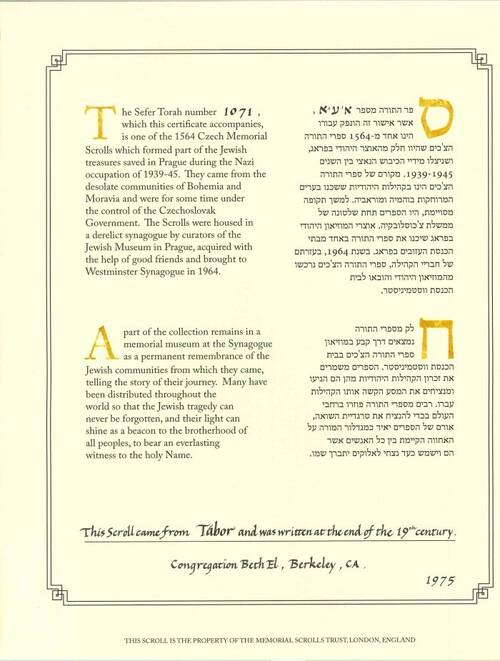THE HOLOCAUST MEMORIAL TORAHS: KLADNO & TÁBOR SCROLLS
THE CZECH TORAH SCROLLS
Congregation Beth El is honored to be the caretaker for two Torah scrolls that are survivors of the Holocaust. These scrolls are on permanent loan from the Memorial Scrolls Trust, an independent charity in London, England. The Trust acquired the scrolls from the Communist Czech government in the early 1960’s, as part of a consignment of over 1500 Torahs. To ensure that the scrolls were actively engaged in ongoing Jewish life, the Trust has permanently loaned many of them to synagogues and other organizations around the world. Each scroll has a unique number marked on a brass plaque on one of the eitzim, and is accompanied by a certificate from the Trust attesting to its history.
KLADNO SCROLL (MST #787)
The Kladno scroll is about 250 years old, and is small and light-weight. It includes stylistic elements and embellishments that were characteristic of the Kabbalistic tradition, including a remarkable Peh Lefufah, or “wrapped peh.“ This Torah is written in a Beit Yosef/Sefaradi-Ashkenazi script on a silver -colored parchment.
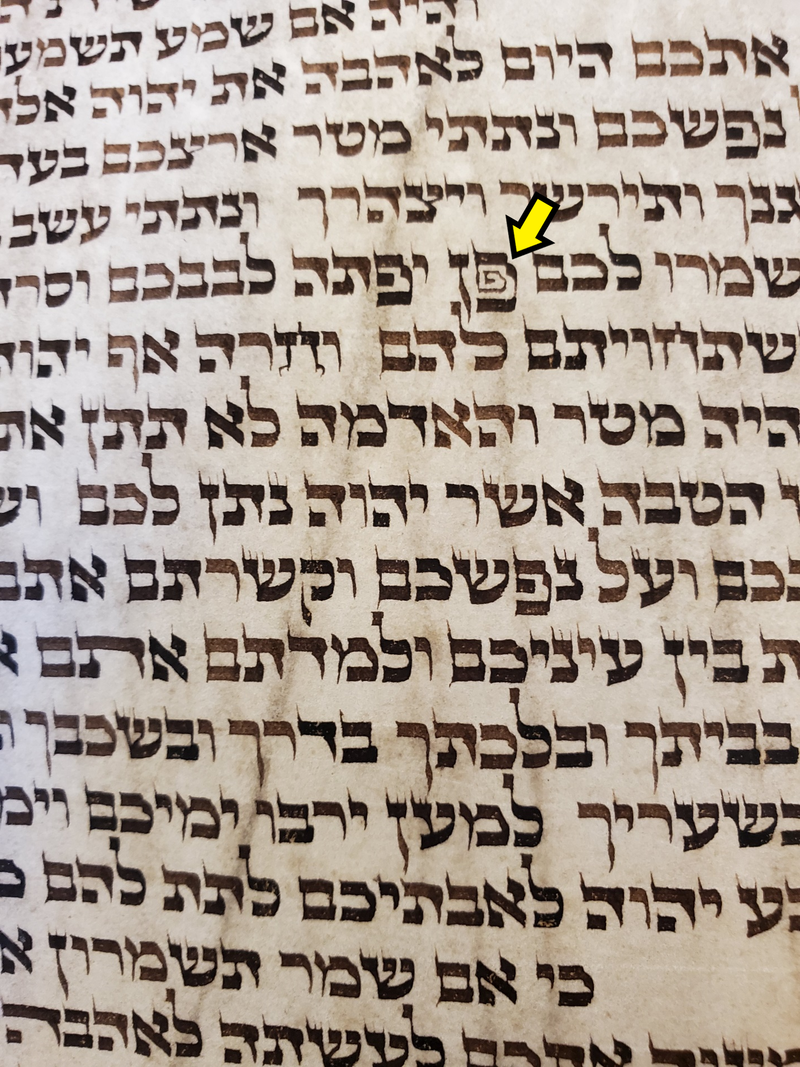
Peh Lefufah
The scroll came from the Jewish community in the town of Kladno, about 25 km northwest of Prague, which was part of the Austrian Empire until 1918. Until the mid-nineteenth century, Jews were not allowed to settle in the mining regions of Austria, including Kladno. The synagogue there was consecrated in 1884. Jews in Kladno became merchants, professionals, and a few owned mines in the area. In March 1939, the German Army entered Kladno, and violence against the Jews began. The Jewish community gave the synagogue to the Hussite church to save it from destruction, and daily services were moved to the funeral pavilion at the nearby Jewish cemetery.
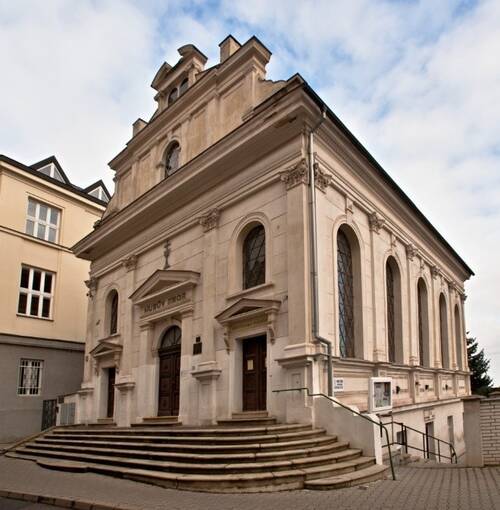

Kladno Synogogue
On February 22 and 26, 1942, two transport trains carried the 1,623 Jews living in the Kladno district to Theresienstadt and from there to concentration and extermination camps where most were killed. Only 124 Jews from Kladno survived the war. Today, there is no Jewish community in Kladno. Congregation Beth El visited Kladno in 2018 as part of a European tour, and met with members of the Hussite Church, which continues to use the former synagogue. A plaque recognizing the synagogue is affixed to the church, and its members continue to honor the memory of the Jews who prayed there.
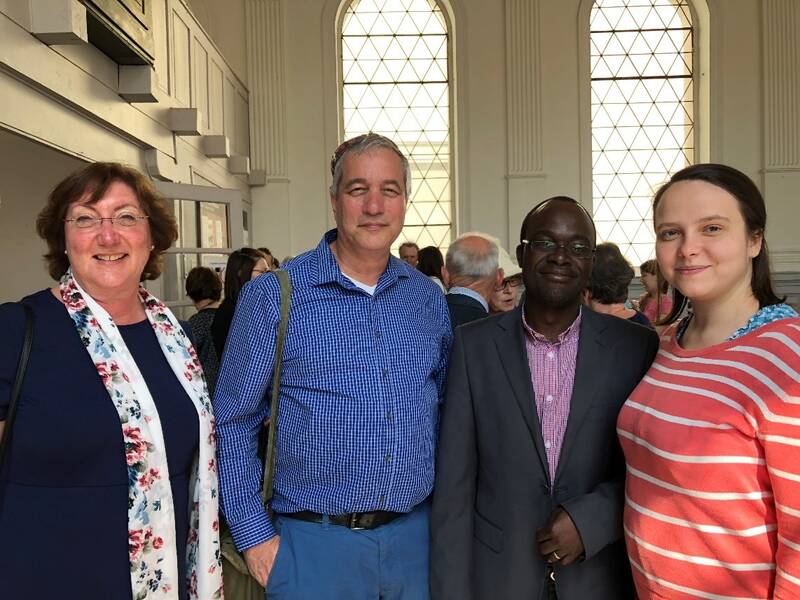

CBE visit to Kladno in 2018
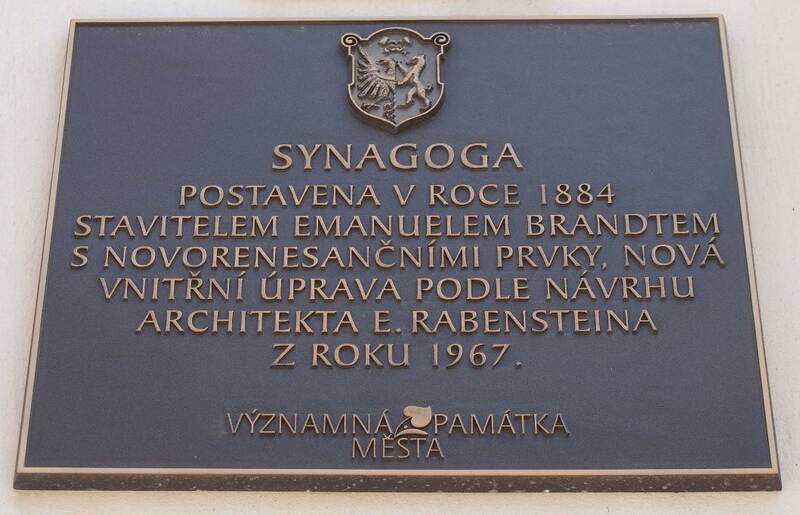
Kladno Plaque affixed to Hussite Church
Translation:
Synagogue
Built in 1884
by the builder Emanuel Brandt
with Neo-renaissance elements, new
interior design according to the design of
architect E. Rabstein from 1967.
An important monument of the city.
Before the community was sent to Theresienstadt, 278 documents, 17 books, and 170 ritual objects including this Torah were sent to the Central Jewish Museum in Prague. Our scroll and nine others from Kladno were eventually acquired by the Memorial Scrolls Trust. Today, the ten scrolls can be found at synagogues across the United States and in the United Kingdom.
The Kladno scroll came to Congregation Beth El in 1984 through the tireless efforts of Emmie and Rabbi George Vida z’’l, and the scroll is nicknamed “Emmie’s scroll” in her memory.
Congregation Beth El says Kaddish each year for the Jews of Kladno on the Shabbat of the anniversary of their transport to the concentration camps, and at Yom Hashoah, Holocaust Remembrance Day, on 27 Nisan each year. Because of significant deterioration of its script, the Kladno scroll is presently not kosher to read from.



TÁBOR SCROLLS (MST #1071)
At 23-1/2 inches, the Tábor scroll is the tallest scroll in the ark. It is about 200 years old.
The Town of Tábor is located 100 km south of Prague, and was also part of the Austrian monarchy until 1918. It is located by the Lužnice river on the edge of the Jordán reservoir, the oldest water reservoir in Central Europe. Prior to 1594, Jews were prohibited in Tábor and records of the first Jewish cemetery and prayer house date to 1630-1640. The town had a long history of attempting to expel the Jews, with disputes with various trades and legal restrictions. Restrictions on the total number of Jewish families living in Tábor continued to be in place until the mid- nineteenth century.
In 1941, Tábor and the villages around it had a Jewish population of 2,352. They were deported to Theresienstadt in November 1942. As in Kladno, prior to the Jews’ final expulsion from Tábor, 422 documents, 15 books, and 215 ritual objects, including our scroll, were transferred to the Central Jewish Museum in Prague.
After the liberation of Tábor in 1945, a total of 145 Jews remained, and another 73 returned from the concentration camps. By 1970, there was only a tiny Jewish population left in Tábor, and today, no Jewish community remains. In 1955, a memorial to the Jews was erected at the cemetery (from which all of the headstones had been removed by the Nazis to be used for construction projects). Tábor’s synagogue building was demolished in 1977 and turned into a
parking lot.


Tábor Synogogue

Tábor Cemetery Memorial
Translation:
A memorial to the martyrs 1939-1945
Whose book of life was prematurely closed
Peace to all


The parking lot where Tábor Synagogue once stood; arrow points at the commemorative plaque
The Tábor scroll at Beth El is one of twenty rescued from that area by the Memorial Trust. The Tábor Torah came to Congregation Beth El in 1975 through the efforts of Rabbi Leo Abrami z’’l, our rabbi at the time. Another local connection: Tábor is the sister city of Orinda, California.
Congregation Beth El says Kaddish for the Jews of Tábor each year in November on the Shabbat of Kristallnacht, and at Yom HaShoah, Holocaust Remembrance Day, on 27 Nissan. The Tábor scroll is also read from during Yom Kippur services each year.
The Tábor scroll is written in a Beit Yosef/Sefaradi-Ashkenazi script in unusually long, wide columns. There was considerable deterioration of the scroll in Bamidbar and Devarim, but through the efforts of the Dan and Robinn Magid family, it was expertly restored in 2009, and is once again kosher to read from.

